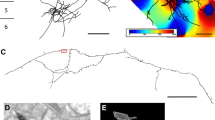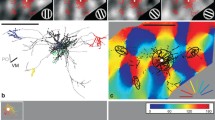Abstract
A nerve net model for the visual cortex of higher vertebrates is presented. A simple learning procedure is shown to be sufficient for the organization of some essential functional properties of single units. The rather special assumptions usually made in the literature regarding preorganization of the visual cortex are thereby avoided. The model consists of 338 neurones forming a sheet analogous to the cortex. The neurones are connected randomly to a “retina” of 19 cells. Nine different stimuli in the form of light bars were applied. The afferent connections were modified according to a mechanism of synaptic training. After twenty presentations of all the stimuli individual cortical neurones became sensitive to only one orientation. Neurones with the same or similar orientation sensitivity tended to appear in clusters, which are analogous to cortical columns. The system was shown to be insensitive to a background of disturbing input excitations during learning. After learning it was able to repair small defects introduced into the wiring and was relatively insensitive to stimuli not used during training.
Similar content being viewed by others
References
Albus,K.: Topology of orientation sensitivity in the cortical areas 17 and 18 of the cat. Pflügers Arch. Suppl. to 339, R 91 (1973)
Benevento,L.A., Creutzfeldt,O.D., Kuhnt,U.: Significance of intracortical inhibitions in the visual cortex. Nature (Lond.) 238, 124–126 (1972)
Beurle,R.L.: Properties of a mass of cells capable of regenerating pulses. Phil. Trans. Roy. Soc. (Lond.) B 240, 55–94 (1956)
Blakemore,C., Cooper,G.F.: Development of the brain depends on the visual environment. Nature (Lond.) 228, 477–478 (1970)
Blakemore,C., Mitchell,D.E.: Environmental modification of the visual cortex and the neural basis of learning and memory. Nature (Lond.) 241, 467–468 (1973)
Bliss,T.V.P., Gardner-Medwin,A.R.: Long-lasting increases of synaptic influence in the unanaesthetized hippocampus. J. Physiol. (Lond.) 216, 32–33 P (1971)
Brindley,G.S.: Nerve net models of plausible size that perform many simple learning tasks. Proc. Roy. Soc. (Lond.) B 174, 173–191 (1969)
Colonnier,H.L.: Structural design of the neocortex. In: Eccles,J.C. (Ed.): Brain and conscious experience, p. 1–21. Berlin-Heidelberg-New York: Springer 1966
Cragg,B.G.: Are there structural alterations in synapses related to functioning? Proc. Roy. Soc. B 171, 319–323 (1968)
Grossberg,S.: Neural expectation: cerebellar and retinal analogs of cells fired by learnable or unlearned pattern classes. Kybernetik 10, 49–57 (1972)
Hebb,D.O.: Organization of Behaviour. New York: John Wiley 1949
Hirsch,H.V.B., Spinelli,D.N.: Visual experience modifies distribution of horizontally and vertically oriented receptive fields in cats. Science 168, 869–871 (1970)
Hubel,D.H., Wiesel,T.N.: Receptive fields, binocular interaction and functional architecture in the cat's visual cortex. J. Physiol. (Lond.) 160, 106–154 (1962)
Hubel,D.H., Wiesel,T.N.: Receptive fields of cells in striate cortex of very young, visually inexperienced kittens. J. Neurophysiol. 26, 994–1002 (1963)
Hubel,D.H., Wiesel,T.N.: Receptive fields and functional architecture of monkey striate cortex. J. Physiol. (Lond.) 195, 215–243 (1968)
Joshua,D.E., Bishop,P.O.: Binocular single vision and depth discrimination. Receptive field disparities for central and peripheral vision and binocular interactions on peripheral single units in cat striate cortex. Exp. Brain. Res. 10, 389–416 (1970)
Marr,D.: Simple memory. Phil. Trans. Roy. Soc. (Lond.) B 262, 23–81 (1971)
Møllgaard,K., Diamond,M.C., Bennett,E.L., Rosenzweig,M.R., Lindner,B.: Quantitative synaptic changes with differential experience in rat brain. Int. J. Neurosci. 2, 113–128 (1971)
Pettigrew,J.D.: The importance of early visual experience for neurones of the developing geniculostriate system. Invest. Ophthal. 11, 386–392 (1972)
Ramon y Cajal,S.: Histologie du système nerveux, Vol. II. Madrid: Consejo Superior de Investigationes Cientifícas, Instituto Ramon y Cajal 1955
Rosenblatt,F.: Principles of neurodynamics: Perceptrons and the theory of brain mechanisms. Washington D.C.: Spartan Books 1961
Ruiz-Marcos,A., Valverde,F.: Dynamic architecture of the visual cortex. Brain Res. 19, 25–39 (1970)
Uttley,A.M.: The informon: a network for adaptive pattern recognition. J. theor. Biol. 27, 31–67 (1970)
Wiesel,T.N., Hubel,D.H.: Comparison of the effects of unilateral and bilateral eye closure on cortical unit responses in kittens. J. Neurophysiol. 28, 1029–1040 (1965)
Author information
Authors and Affiliations
Rights and permissions
About this article
Cite this article
von der Malsburg, C. Self-organization of orientation sensitive cells in the striate cortex. Kybernetik 14, 85–100 (1973). https://doi.org/10.1007/BF00288907
Received:
Issue Date:
DOI: https://doi.org/10.1007/BF00288907




